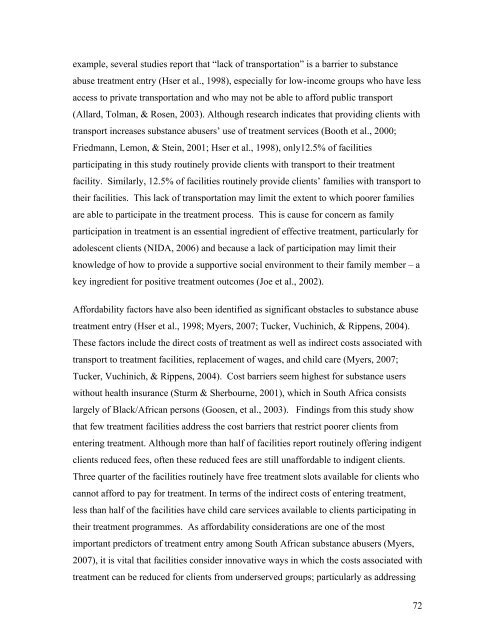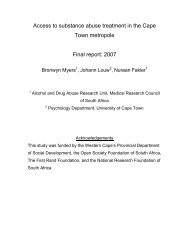Audit of Substance Abuse Treatment Facilities in ... - SA HealthInfo
Audit of Substance Abuse Treatment Facilities in ... - SA HealthInfo
Audit of Substance Abuse Treatment Facilities in ... - SA HealthInfo
- No tags were found...
You also want an ePaper? Increase the reach of your titles
YUMPU automatically turns print PDFs into web optimized ePapers that Google loves.
example, several studies report that “lack <strong>of</strong> transportation” is a barrier to substanceabuse treatment entry (Hser et al., 1998), especially for low-<strong>in</strong>come groups who have lessaccess to private transportation and who may not be able to afford public transport(Allard, Tolman, & Rosen, 2003). Although research <strong>in</strong>dicates that provid<strong>in</strong>g clients withtransport <strong>in</strong>creases substance abusers’ use <strong>of</strong> treatment services (Booth et al., 2000;Friedmann, Lemon, & Ste<strong>in</strong>, 2001; Hser et al., 1998), only12.5% <strong>of</strong> facilitiesparticipat<strong>in</strong>g <strong>in</strong> this study rout<strong>in</strong>ely provide clients with transport to their treatmentfacility. Similarly, 12.5% <strong>of</strong> facilities rout<strong>in</strong>ely provide clients’ families with transport totheir facilities. This lack <strong>of</strong> transportation may limit the extent to which poorer familiesare able to participate <strong>in</strong> the treatment process. This is cause for concern as familyparticipation <strong>in</strong> treatment is an essential <strong>in</strong>gredient <strong>of</strong> effective treatment, particularly foradolescent clients (NIDA, 2006) and because a lack <strong>of</strong> participation may limit theirknowledge <strong>of</strong> how to provide a supportive social environment to their family member – akey <strong>in</strong>gredient for positive treatment outcomes (Joe et al., 2002).Affordability factors have also been identified as significant obstacles to substance abusetreatment entry (Hser et al., 1998; Myers, 2007; Tucker, Vuch<strong>in</strong>ich, & Rippens, 2004).These factors <strong>in</strong>clude the direct costs <strong>of</strong> treatment as well as <strong>in</strong>direct costs associated withtransport to treatment facilities, replacement <strong>of</strong> wages, and child care (Myers, 2007;Tucker, Vuch<strong>in</strong>ich, & Rippens, 2004). Cost barriers seem highest for substance userswithout health <strong>in</strong>surance (Sturm & Sherbourne, 2001), which <strong>in</strong> South Africa consistslargely <strong>of</strong> Black/African persons (Goosen, et al., 2003). F<strong>in</strong>d<strong>in</strong>gs from this study showthat few treatment facilities address the cost barriers that restrict poorer clients fromenter<strong>in</strong>g treatment. Although more than half <strong>of</strong> facilities report rout<strong>in</strong>ely <strong>of</strong>fer<strong>in</strong>g <strong>in</strong>digentclients reduced fees, <strong>of</strong>ten these reduced fees are still unaffordable to <strong>in</strong>digent clients.Three quarter <strong>of</strong> the facilities rout<strong>in</strong>ely have free treatment slots available for clients whocannot afford to pay for treatment. In terms <strong>of</strong> the <strong>in</strong>direct costs <strong>of</strong> enter<strong>in</strong>g treatment,less than half <strong>of</strong> the facilities have child care services available to clients participat<strong>in</strong>g <strong>in</strong>their treatment programmes. As affordability considerations are one <strong>of</strong> the mostimportant predictors <strong>of</strong> treatment entry among South African substance abusers (Myers,2007), it is vital that facilities consider <strong>in</strong>novative ways <strong>in</strong> which the costs associated withtreatment can be reduced for clients from underserved groups; particularly as address<strong>in</strong>g72
















